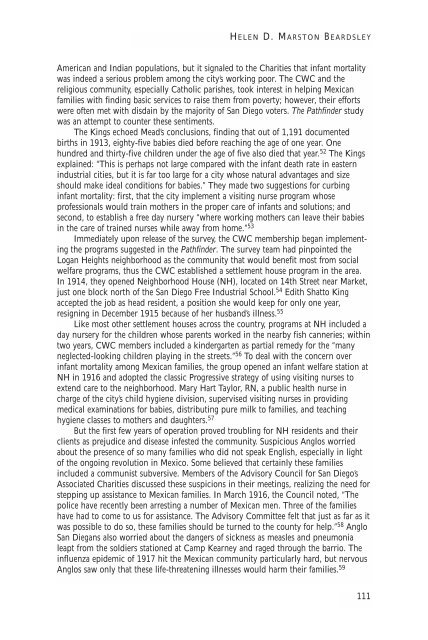Helen D. Marston Beardsley and Progressive Activism - San Diego ...
Helen D. Marston Beardsley and Progressive Activism - San Diego ...
Helen D. Marston Beardsley and Progressive Activism - San Diego ...
You also want an ePaper? Increase the reach of your titles
YUMPU automatically turns print PDFs into web optimized ePapers that Google loves.
H ELEN D. MARSTON B EARDSLEY<br />
American <strong>and</strong> Indian populations, but it signaled to the Charities that infant mortality<br />
was indeed a serious problem among the city’s working poor. The CWC <strong>and</strong> the<br />
religious community, especially Catholic parishes, took interest in helping Mexican<br />
families with finding basic services to raise them from poverty; however, their efforts<br />
were often met with disdain by the majority of <strong>San</strong> <strong>Diego</strong> voters. The Pathfinder study<br />
was an attempt to counter these sentiments.<br />
The Kings echoed Mead’s conclusions, finding that out of 1,191 documented<br />
births in 1913, eighty-five babies died before reaching the age of one year. One<br />
hundred <strong>and</strong> thirty-five children under the age of five also died that year. 52 The Kings<br />
explained: “This is perhaps not large compared with the infant death rate in eastern<br />
industrial cities, but it is far too large for a city whose natural advantages <strong>and</strong> size<br />
should make ideal conditions for babies.” They made two suggestions for curbing<br />
infant mortality: first, that the city implement a visiting nurse program whose<br />
professionals would train mothers in the proper care of infants <strong>and</strong> solutions; <strong>and</strong><br />
second, to establish a free day nursery “where working mothers can leave their babies<br />
in the care of trained nurses while away from home.” 53<br />
Immediately upon release of the survey, the CWC membership began implementing<br />
the programs suggested in the Pathfinder. The survey team had pinpointed the<br />
Logan Heights neighborhood as the community that would benefit most from social<br />
welfare programs, thus the CWC established a settlement house program in the area.<br />
In 1914, they opened Neighborhood House (NH), located on 14th Street near Market,<br />
just one block north of the <strong>San</strong> <strong>Diego</strong> Free Industrial School. 54 Edith Shatto King<br />
accepted the job as head resident, a position she would keep for only one year,<br />
resigning in December 1915 because of her husb<strong>and</strong>’s illness. 55<br />
Like most other settlement houses across the country, programs at NH included a<br />
day nursery for the children whose parents worked in the nearby fish canneries; within<br />
two years, CWC members included a kindergarten as partial remedy for the “many<br />
neglected-looking children playing in the streets.” 56 To deal with the concern over<br />
infant mortality among Mexican families, the group opened an infant welfare station at<br />
NH in 1916 <strong>and</strong> adopted the classic <strong>Progressive</strong> strategy of using visiting nurses to<br />
extend care to the neighborhood. Mary Hart Taylor, RN, a public health nurse in<br />
charge of the city’s child hygiene division, supervised visiting nurses in providing<br />
medical examinations for babies, distributing pure milk to families, <strong>and</strong> teaching<br />
hygiene classes to mothers <strong>and</strong> daughters. 57<br />
But the first few years of operation proved troubling for NH residents <strong>and</strong> their<br />
clients as prejudice <strong>and</strong> disease infested the community. Suspicious Anglos worried<br />
about the presence of so many families who did not speak English, especially in light<br />
of the ongoing revolution in Mexico. Some believed that certainly these families<br />
included a communist subversive. Members of the Advisory Council for <strong>San</strong> <strong>Diego</strong>’s<br />
Associated Charities discussed these suspicions in their meetings, realizing the need for<br />
stepping up assistance to Mexican families. In March 1916, the Council noted, “The<br />
police have recently been arresting a number of Mexican men. Three of the families<br />
have had to come to us for assistance. The Advisory Committee felt that just as far as it<br />
was possible to do so, these families should be turned to the county for help.” 58 Anglo<br />
<strong>San</strong> Diegans also worried about the dangers of sickness as measles <strong>and</strong> pneumonia<br />
leapt from the soldiers stationed at Camp Kearney <strong>and</strong> raged through the barrio. The<br />
influenza epidemic of 1917 hit the Mexican community particularly hard, but nervous<br />
Anglos saw only that these life-threatening illnesses would harm their families. 59 111







![[PDF] The Journal of San Diego History Vol 52: Nos 1 & 2](https://img.yumpu.com/25984149/1/172x260/pdf-the-journal-of-san-diego-history-vol-52-nos-1-2.jpg?quality=85)

![[PDF] The Journal of San Diego History - San Diego History Center](https://img.yumpu.com/25984131/1/172x260/pdf-the-journal-of-san-diego-history-san-diego-history-center.jpg?quality=85)







